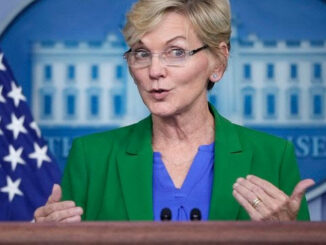
The DOI’s updated review procedures now mandate senior leadership, including the Secretary’s office, to conduct final reviews of decisions on wind and solar projects, covering leases, rights-of-way, construction plans, and biological opinions.
This was a cool clip from Fox and @SecretaryWright going over the updates. It is refreshing to have an Energy Department that understands business. Chris is again spot on the market. pic.twitter.com/NscRqW8ynq
— STUART TURLEY – Energy Podcast Host (@STUARTTURLEY16) July 19, 2025
This change is part of the “One Big Beautiful Bill Act,” which specifically eliminates right-of-way and capacity fee discounts for both existing and future wind and solar developments.
Acting Assistant Secretary for Lands and Minerals Adam Suess emphasized that these actions fulfill Trump’s promise to combat the “Green New Scam” and safeguard taxpayer dollars.
Suess stated, “American energy dominance is driven by U.S.-based production of reliable baseload energy, not regulatory favoritism towards unreliable [energy projects] that are solely dependent on taxpayer subsidies and foreign-sourced equipment.”
The rationale behind these changes centers on claims of preferential treatment under the previous Biden administration, which allegedly expedited permitting for renewables while sidelining more “dispatchable” sources.
Trump’s executive order, “Ending Market Distorting Subsidies for Unreliable, Foreign-Controlled Energy Sources,” highlights how such subsidies threaten national security by fostering dependence on foreign supply chains.
By removing these “artificial advantages,” the DOI aims to promote grid stability, job creation, and energy security through sources like clean coal and domestic natural gas.
This Interior Department action is part of a wider Trump administration push to recalibrate U.S. energy policy away from heavy reliance on wind and solar. At the Department of Energy (DOE), recent budgets propose slashing funding for renewable energy programs, including over $15 billion in carbon capture and renewables support from prior bipartisan legislation.
Similarly, the Environmental Protection Agency (EPA) faces proposals to dismantle its renewable energy initiatives and reduce funding for environmental justice programs, as outlined in conservative policy blueprints like Project 2025.
In one notable move, the EPA placed 144 officials on leave after they signed a letter criticizing the agency’s “energy dominance” agenda, which prioritizes fossil fuels over renewables.
Trump’s executive orders further underscore this shift, rescinding decades-old environmental rules to “unleash American energy” and modernize permitting for infrastructure, potentially slowing approvals for variable renewables while fast-tracking traditional projects.
House Republicans have advanced a version of Trump’s policy bill that would eliminate tax credits for low-emission sources such as wind, solar, batteries, and geothermal entirely.
Industry observers note that these changes create uncertainty for renewable investments, with the threat becoming evident shortly after Trump’s reelection.
Fueling these policy changes is growing concern over grid reliability, as detailed in the DOE’s July 7, 2025, report. The document warns of severe risks by 2030, driven by a 16% surge in electricity demand from AI data centers and manufacturing, adding 35–108 GW of load.
With 104 GW of plant retirements (primarily coal) outpacing reliable additions—only 22 GW of new firm baseload like natural gas and nuclear from 209 GW total—it predicts outage risks could skyrocket 100-fold, resulting in over 800 annual outage hours.
The report critiques over-reliance on variable renewable energy (VRE) like wind and solar, which contributes to planning gaps in models that overlook outage frequency, duration, and regional interdependencies.
It advocates for a balanced mix emphasizing firm, dispatchable sources to maintain reliability, particularly in high-risk areas like PJM and ERCOT, each needing 10.5 GW of “perfect capacity.”
The DOE recommends interventions to delay critical retirements and streamline emergency orders under the Federal Power Act.
For investors, this strained landscape presents opportunities in companies focused on reliable energy. The report highlights firms like Peabody Energy (coal), Constellation Energy (nuclear), NextEra Energy (mixed but with baseload), Vistra Corp (gas and nuclear), and GE Vernova (grid tech) as well-positioned to capitalize on the need for modernization and firm power.
As the Trump administration pivots toward energy dominance through traditional sources, these shifts could reshape the sector, prioritizing stability over subsidies and opening doors for strategic investments in a more resilient grid






